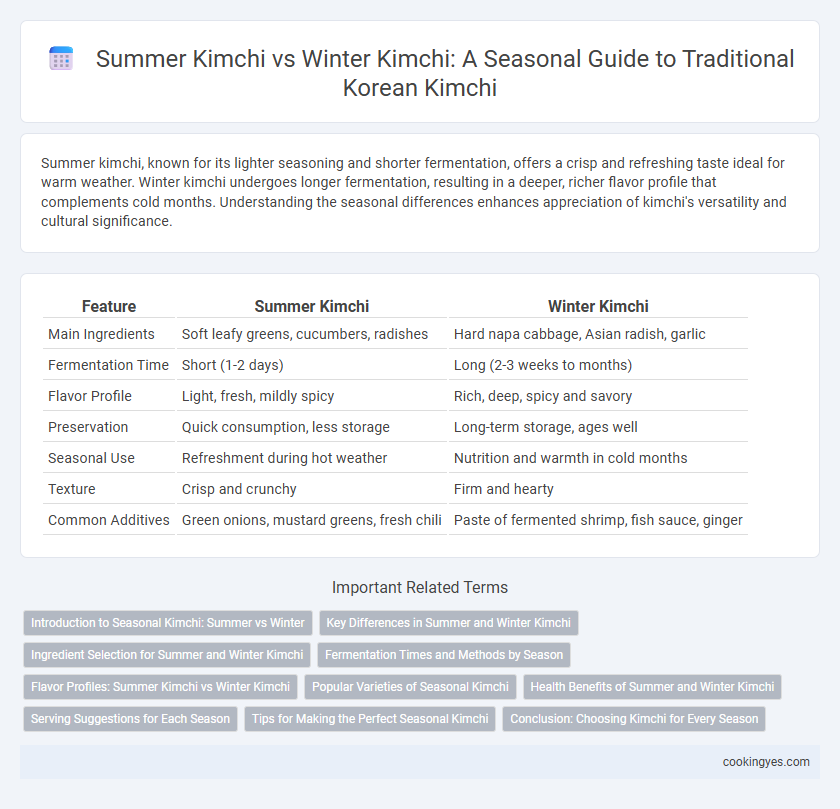Summer kimchi, known for its lighter seasoning and shorter fermentation, offers a crisp and refreshing taste ideal for warm weather. Winter kimchi undergoes longer fermentation, resulting in a deeper, richer flavor profile that complements cold months. Understanding the seasonal differences enhances appreciation of kimchi's versatility and cultural significance.
Table of Comparison
| Feature | Summer Kimchi | Winter Kimchi |
|---|---|---|
| Main Ingredients | Soft leafy greens, cucumbers, radishes | Hard napa cabbage, Asian radish, garlic |
| Fermentation Time | Short (1-2 days) | Long (2-3 weeks to months) |
| Flavor Profile | Light, fresh, mildly spicy | Rich, deep, spicy and savory |
| Preservation | Quick consumption, less storage | Long-term storage, ages well |
| Seasonal Use | Refreshment during hot weather | Nutrition and warmth in cold months |
| Texture | Crisp and crunchy | Firm and hearty |
| Common Additives | Green onions, mustard greens, fresh chili | Paste of fermented shrimp, fish sauce, ginger |
Introduction to Seasonal Kimchi: Summer vs Winter
Summer kimchi, known as yeolmu kimchi, features young radish greens with a refreshing, crisp texture and lighter seasoning suited to warmer temperatures. Winter kimchi, such as baechu kimchi, utilizes mature Napa cabbage, fermented longer to develop richer flavors and enhanced probiotic benefits that aid digestion during colder months. Both varieties showcase seasonal ingredient availability and tailored fermentation times to optimize taste and nutritional properties throughout the year.
Key Differences in Summer and Winter Kimchi
Summer kimchi, known as "Yeolmu Kimchi," typically features young radishes and leafy vegetables with a lighter, more refreshing flavor to help combat heat and humidity. Winter kimchi, often called "Napa Cabbage Kimchi," involves thicker, heartier vegetables with more fermentation time for a robust, deep flavor suitable for cold months. The difference in fermentation temperature and vegetable texture significantly impacts the taste, texture, and preservation of summer versus winter kimchi.
Ingredient Selection for Summer and Winter Kimchi
Summer kimchi typically features lighter, fresher ingredients like young radishes, cucumbers, and green onions to enhance its crisp and refreshing taste. In contrast, winter kimchi utilizes heartier vegetables such as Napa cabbage and Korean radish, combined with robust seasonings including garlic, ginger, and chili flakes to withstand colder temperatures. The ingredient selection for each season reflects the need to balance fermentation speed and preservation, optimizing flavor development year-round.
Fermentation Times and Methods by Season
Summer kimchi undergoes a shorter fermentation process, typically lasting one to three days, due to higher temperatures that accelerate bacterial activity and flavor development. Winter kimchi requires extended fermentation periods, often several weeks to months, to achieve its characteristic depth of taste under colder conditions that slow down microbial fermentation. Traditional methods include fermenting summer kimchi in cooler, shaded areas or refrigeration to control rapid fermentation, while winter kimchi is stored in earthenware jars buried underground or in cold cellars to maintain consistent low temperatures.
Flavor Profiles: Summer Kimchi vs Winter Kimchi
Summer kimchi features a lighter, fresher flavor profile with a tangy and mildly spicy taste, emphasizing ingredients like young radishes and cucumbers that provide crispness and a cooling sensation. Winter kimchi boasts a richer, deeper flavor with robust umami and stronger spiciness, often incorporating aged Napa cabbage and fermented seafood to enhance its hearty and warming characteristics. The seasonal variation in fermentation times and ingredient choices directly influence the distinct flavor profiles, making summer kimchi ideal for refreshing meals and winter kimchi perfect for comforting, nutrient-dense dishes.
Popular Varieties of Seasonal Kimchi
Summer kimchi, known as yeolmu kimchi, primarily features young radish greens and offers a refreshing, lighter flavor suited for warm weather. Winter kimchi varieties like baechu kimchi use Napa cabbage and are fermented longer, resulting in a richer, robust taste ideal for cold seasons. These seasonal variations highlight the versatility of kimchi through distinct ingredient choices and fermentation times adapted to climatic conditions.
Health Benefits of Summer and Winter Kimchi
Summer kimchi, typically made with fresh, crunchy vegetables like cucumbers and radishes, is rich in antioxidants and vitamins such as vitamin C that boost immunity and aid hydration during hot weather. Winter kimchi, often aged longer and made with hearty ingredients like napa cabbage and garlic, contains higher levels of probiotics that strengthen gut health and enhance digestion in colder months. Both seasonal kimchis provide essential nutrients, but summer kimchi offers cooling, refreshing properties while winter kimchi delivers warming, immune-supportive benefits ideal for seasonal health maintenance.
Serving Suggestions for Each Season
Summer kimchi, lighter and less fermented, pairs well with grilled fish, cold noodles, or chilled tofu dishes to complement its refreshing, tangy flavors. Winter kimchi, richer and more deeply fermented, enhances hearty meals like stews, braised pork, and hot pot, adding warmth and umami during colder months. Serving summer kimchi fresh maximizes its crisp texture, whereas winter kimchi benefits from slow cooking to meld its robust taste with savory winter dishes.
Tips for Making the Perfect Seasonal Kimchi
Summer kimchi should be prepared with lighter fermentation techniques and fresh, crunchy vegetables like cucumbers and young radishes to capture its refreshing, tangy flavor, while winter kimchi requires richer seasoning with aged napa cabbage and robust ingredients such as garlic and ginger for deep, complex flavors. Maintain precise temperature control during fermentation, ideally 15-20degC for summer kimchi and below 10degC for winter kimchi, to optimize microbial activity and prevent over-ripening. Balancing salt concentration and utilizing traditional Korean fermentation vessels like onggi pots can enhance the texture and authenticity of seasonal kimchi varieties.
Conclusion: Choosing Kimchi for Every Season
Summer kimchi, or yeolmu kimchi, features young radish greens with a lighter, fresher flavor ideal for hot weather, while winter kimchi, such as baechu kimchi, uses mature napa cabbage with a robust, deeply fermented taste perfect for cold months. Selecting kimchi according to the season enhances both flavor and nutritional benefits, aligning with traditional Korean fermentation practices. Embracing seasonal kimchi varieties supports digestive health and balances body temperature throughout the year.
Summer Kimchi vs Winter Kimchi for seasonal kimchi Infographic

 cookingyes.com
cookingyes.com